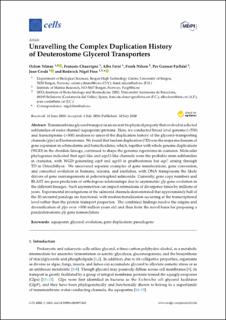| dc.description.abstract | Transmembrane glycerol transport is an ancient biophysical property that evolved in selected subfamilies of water channel (aquaporin) proteins. Here, we conducted broad level genome (>550) and transcriptome (>300) analyses to unravel the duplication history of the glycerol-transporting channels (glps) in Deuterostomia. We found that tandem duplication (TD) was the major mechanism of gene expansion in echinoderms and hemichordates, which, together with whole genome duplications (WGD) in the chordate lineage, continued to shape the genomic repertoires in craniates. Molecular phylogenies indicated that aqp3-like and aqp13-like channels were the probable stem subfamilies in craniates, with WGD generating aqp9 and aqp10 in gnathostomes but aqp7 arising through TD in Osteichthyes. We uncovered separate examples of gene translocations, gene conversion, and concerted evolution in humans, teleosts, and starfishes, with DNA transposons the likely drivers of gene rearrangements in paleotetraploid salmonids. Currently, gene copy numbers and BLAST are poor predictors of orthologous relationships due to asymmetric glp gene evolution in the different lineages. Such asymmetries can impact estimations of divergence times by millions of years. Experimental investigations of the salmonid channels demonstrated that approximately half of the 20 ancestral paralogs are functional, with neofunctionalization occurring at the transcriptional level rather than the protein transport properties. The combined findings resolve the origins and diversification of glps over >800 million years old and thus form the novel basis for proposing a pandeuterostome glp gene nomenclature | en_US |
